[fresh, washed produce.]
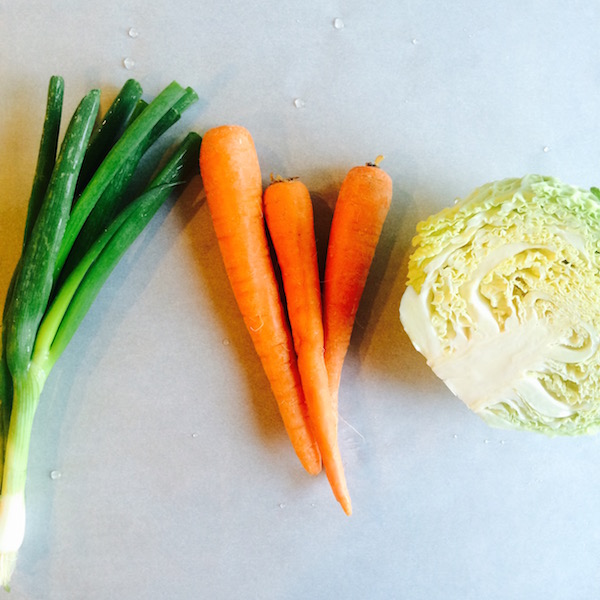
Soba is the Japanese word for buckwheat. And buckwheat is naturally a gluten-free grain. I know that’s kind of confusing since the name implies wheat or gluten, but it’s true, buckwheat is naturally gluten-free. Yay for all you gluten-free eaters out there! Whole grain buckwheat can be found in noodle form or as buckwheat groats which can be cooked up similar to quinoa or rice. Many soba noodles brands contain both buckwheat and wheat flour [not gluten-free], so be sure to find a brand that contains 100% whole buckwheat noodles, similar to this brand [pictured below] that I found at a local co-op.
[100% whole buckwheat noodles; whole grains at their finest.]

Whole grains vs. refined grains.
Many times I ask my clients if they know the difference between whole and refined grains, and more often than not they’re just not quite sure. It’s an important nutrition topic that shouldn’t be overlooked, so here’s the quick and dirty on refined grains vs. whole grains.
Refined grains.
Refined grains are just that. Refined. Refining is a form of processing which essentially takes out most [if not all] of the nutrients and fiber. Basically all the health-promoting benefits are lost. What you’re left with is a highly processed grain that’s low in fiber and high in simple carbohydrates which get digested quickly to spike your blood sugar, which is not a good thing. Examples of refined grains are: enriched flour, bleached flour, flour, white flour, white rice, rice, corn, etc. Essentially, if you don’t see the word whole on your food label, it’s most likely a refined grain and should be avoided. Think of refined grains like white sugar. We know processed sugar is bad for us, so why eat refined grains which are essentially digested as sugar?
Whole grains.
Whole grains are what nature intended. They are processed much less than refined grains and still contain many beneficial nutrients including B vitamins and fiber. The fiber is essential to slow digestion and decrease a huge blood sugar response which you would get from consuming the grain in a refined form. When looking for whole grains you must read all ingredient labels. Find the word whole in front of any grain and you can ensure it’s a whole grain product [but don’t just look at the first ingredient in the list, all grains in a product should be whole, not just the first one]. There are a few exceptions though. For example, the following whole grains do not need to say the word whole in order to be considered a whole grain: quinoa, brown rice [or any colored rice other than white], wild rice and oats.
[color, texture, nutrition.]

Benefits of eating raw foods.
I often encourage people to consume at least 5 servings of vegetables per day. And while there is absolutely nothing wrong with eating cooked veggies [roasted, sautéed, steamed, etc.], eating them in their raw form can provide many health-promoting benefits:
- all nutrients will remain intact and active [cooking can decrease nutrient content slightly]
- beneficial enzymes remain which aid in digestion
- high in fiber so slow digestion and keep you satisfied longer
- typically takes longer to chew completely which slows you down at meal times
[wild-caught salmon, mmmmm.]
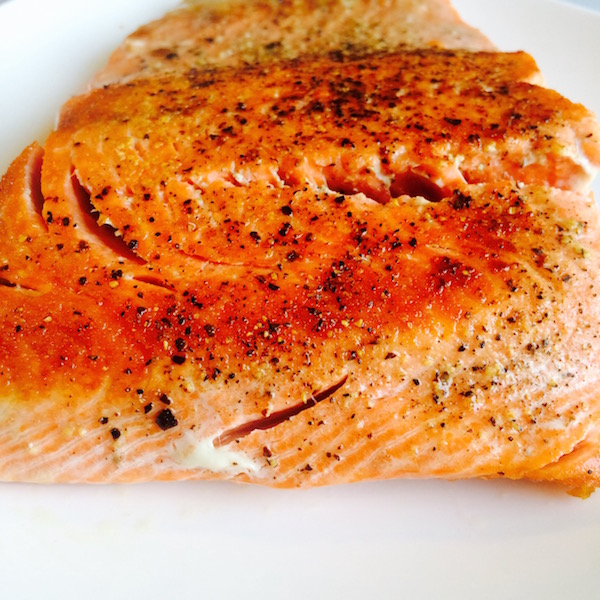
Salmon and healthy omega-3 fats.
Dietary fats are a topic most people are either confused about or unaware of. Healthy anti-inflammatory omega-3 fats are lacking in most of our diets which may be contributing to the health crisis we’re currently experiencing. And as a nation we are grossly over-consuming pro-inflammatory omega-6 fats which are contributing to inflammation + chronic disease.
Eating fat is an important part of having a healthy diet, but it’s the healthy fats we need to be consuming more of, while limiting the unhealthy ones. Omega-3 fats [specifically EPA and DHA] are one of the healthiest fats you can eat. They’re found most abundantly in wild-caught seafood and a few other foods. If you want to learn more about healthy vs. unhealthy fats, check out my free nutrition guide, 5 Reasons to Eat More Fat.
Omega-3 foods to eat.
- wild-caught fish
- high quality fish oil supplement – ask me about fish oil supplements that I recommend!
- seeds [flax, chia, hemp]
[ready to assemble.]
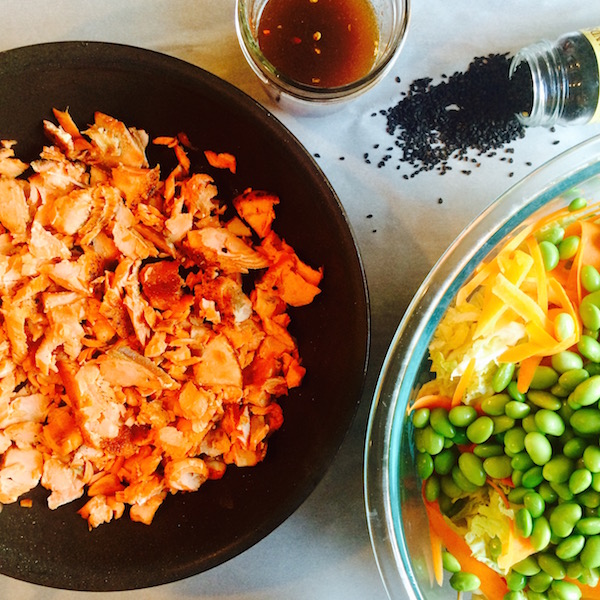
Black sesame seeds have a very similar flavor to the typical white seeds you may be used to. I just love the way the black seeds look which is why I chose to go with the black ones for this dish. And for some added nutty flavor, you could toast your sesame seeds in a pan on the stove for a few minutes. Be careful not to burn them though.
[dish up and dig in.]

Check out the full detailed recipe + directions below! And feel free to add in some of your favorite raw veggies like bell peppers, zucchini, etc. The more veggies the better.
[looks almost too good to eat..almost.]
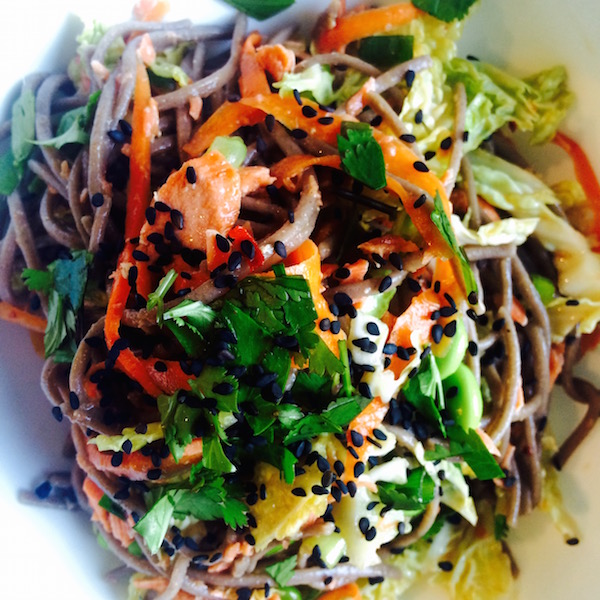
Salmon Soba Noodle Bowl
servings: about 6
Ingredients
- 1 8 oz. package buckwheat noodles
- 1 filet of wild-caught salmon [about 1 pound or 16 oz.]
- 1 Tbsp olive oil or coconut oil [to cook salmon]
- 3 carrots, peeled + sliced thinly [I run my vegetable peeler down all sides of carrot to slice thinly]
- ½ head savoy cabbage, sliced thinly
- 1 10 oz. package organic frozen shelled edamame, defrosted
- 5-6 scallions, diced
- Juice of 2 limes
- 3 Tbsp toasted sesame oil
- ¼ cup coconut aminos [or tamari or soy sauce – if using tamari or soy sauce, reduce to 2 Tbsp + add 2 Tbsp water]
- 1 Tbsp honey
- 1 tsp red pepper flakes [optional]
- Black sesame seeds [for serving]
- Handful fresh cilantro, coarsely chopped
- sea salt + black pepper [for salmon]
Directions
Cook buckwheat noodles according to package directions. Once done, rinse with cold water and set aside. Season salmon with sea salt + black pepper. Heat olive or coconut oil to medium heat in large sauté pan. Add salmon [skin side down] into hot pan and cook for 5-6 minutes. Flip salmon over and cook for another 5 minutes until no longer opaque and cooked through. Remove skin and flake into bite-size pieces. Set aside. Meanwhile, prepare all veggies [peel and slice carrots, chop up cabbage, slice scallions, defrost edamame]. Add veggies to large mixing bowl and set aside. To prepare dressing/sauce: combine sesame oil, lime juice, coconut aminos, honey and red pepper flakes in a mason jar or small bowl. Shake or stir well to combine. To assemble dish, add cooked noodles and salmon to large bowl with vegetables, pour sauce over and toss well to combine, making sure that everything is coated. To serve, top with fresh cilantro, black sesame seeds and an extra squeeze of lime juice if desired. Enjoy room temperature or cold. This dish tastes even better the next day after the flavors have had a chance to marinate in the fridge.
- 1 8 oz. package buckwheat noodles
- 1 filet of wild-caught salmon [about 1 pound or 16 oz.]
- 1 Tbsp olive oil or coconut oil [to cook salmon]
- 3 carrots, peeled + sliced thinly [I run my vegetable peeler down all sides of carrot to slice thinly]
- ½ head savoy cabbage, sliced thinly
- 1 10 oz. package organic frozen shelled edamame, defrosted
- 5-6 scallions, diced
- Juice of 2 limes
- 3 Tbsp toasted sesame oil
- ¼ cup coconut aminos [or tamari or soy sauce - if using tamari or soy sauce, reduce to 2 Tbsp + add 2 Tbsp water]
- 1 Tbsp honey
- 1 tsp red pepper flakes [optional]
- Black sesame seeds [for serving]
- Handful fresh cilantro, coarsely chopped
- sea salt + black pepper [for salmon]
- Cook buckwheat noodles according to package directions. Once done, rinse with cold water and set aside.
- Season salmon with sea salt + black pepper.
- Heat olive or coconut oil to medium heat in large sauté pan.
- Add salmon [skin side down] into hot pan and cook for 5-6 minutes. Flip salmon over and cook for another 5 minutes until no longer opaque and cooked through.
- Remove skin and flake into bite-size pieces. Set aside.
- Meanwhile, prepare all veggies [peel and slice carrots, chop up cabbage, slice scallions, defrost edamame].
- Add veggies to large mixing bowl and set aside.
- To prepare dressing/sauce: combine sesame oil, lime juice, coconut aminos, honey and red pepper flakes in a mason jar or small bowl. Shake or stir well to combine.
- To assemble dish, add cooked noodles and salmon to large bowl with vegetables, pour sauce over and toss well to combine, making sure that everything is coated.
- To serve, top with fresh cilantro, black sesame seeds and an extra squeeze of lime juice if desired.
- Enjoy room temperature or cold. This dish tastes even better the next day after the flavors have had a chance to marinate in the fridge.
What did you think about this recipe? Let me know in the comments below! 🙂


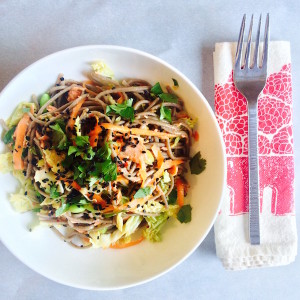
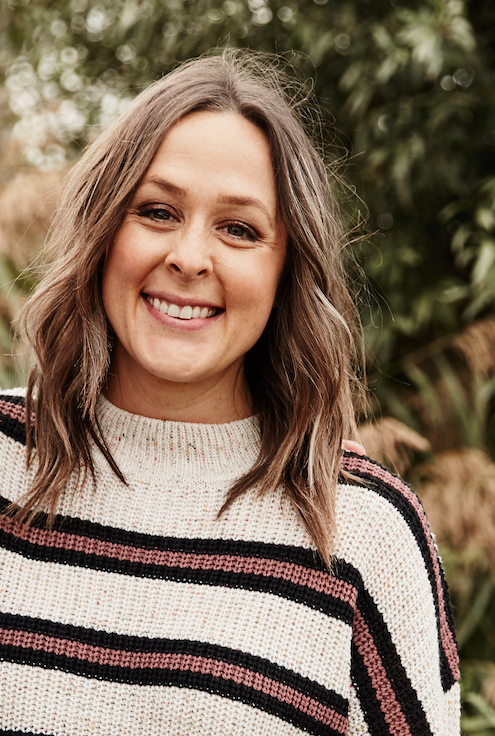


Recent Comments